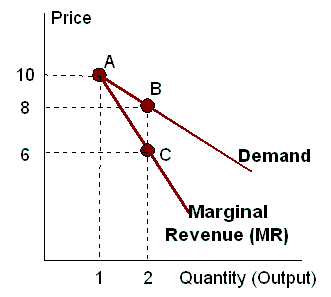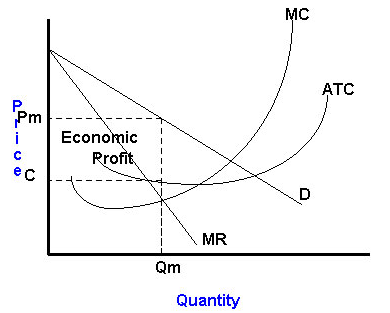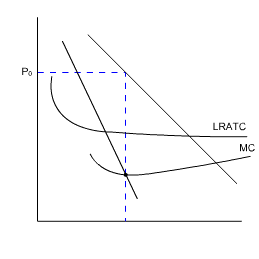Do you want BuboFlash to help you learning these things? Or do you want to add or correct something? Click here to log in or create user.
Subject 5. Monopoly
#cfa #cfa-level #economics #has-images #microeconomics #reading-16-the-firm-and-market-structures
Literally, monopoly means "single seller." It is a market structure characterized by:
MR < P





- High entry barriers.
- A single seller of a well-defined product for which there are no good substitutes.
Barriers to entry include legal or natural constraints that protect a firm from potential competitors.
- Legal barriers to entry create a legal monopoly, a market in which competition and entry are restricted by the granting of a:
- Public franchise. The U.S. Postal Service franchises to deliver first-class mail.
- Government license. Licensing is a requirement that one obtain permission from the government in order to perform certain business activities or work in various occupations. It limits entry and restricts the right to buy and sell goods. Sometimes these licenses cost little and are designed to ensure certain minimum standards. In other cases, they are expensive and designed primarily to limit competition. For example, in many U.S. states a license is required for operating a taxi.
- Patent and copyright. The entry barrier created by the grant of a patent generally leads to higher consumer prices for products that have already been developed. On the other hand, the absence of patent protection might well lead to a slowdown in the pace of technological innovation.
- Natural barriers to entry (for example, economies of scale) create a natural monopoly, which is an industry in which one firm can supply the entire market at a lower price than two or more firms can. In some industries, larger firms will always have lower unit costs. It will be difficult for small firms to enter the market, build a reputation, and compete effectively. Economies of scale tend to eventually result in the market being dominated by one large firm.
- Other barriers, such as strong brand loyalty or the increasing returns associated with network effects.
Demand and Supply Analysis
A monopoly faces no competition, and as a result there is no product differentiation. It is a price setter, not a price taker like a firm in perfect competition. Because the monopoly is the only seller in the market, the demand for its product is the market demand curve. It is downward-sloping because demand will decline as price increases.
Marginal Revenue and Price
A monopoly must choose between lower prices with larger quantities sold and higher prices with smaller sales. Although a monopoly can set the price for its products, market forces will determine the quantity sold at alternative prices. To maximize profit, a monopoly must estimate the relationship between price and the quantity of its products demanded.
As the monopoly reduces price in order to expand output and sales, there will be two conflicting influences on total revenue.
- The increase in sales due to the lower price will, by itself, add to the revenue of the monopoly.
- The price reduction, however, also applies to units that would otherwise have been sold at a higher price. This factor will cause a reduction in total revenue.
These two conflicting forces will result in marginal revenue - the change in total revenue - that is less than the sales price of the additional units. Thus, the marginal revenue curve of the monopoly will always lie below the firm's demand curve, which is also the market's demand curve:
The following example illustrates this concept.

Portico produces beauty soaps.
- If Portico charges $10 for each bar of soap, the demand will be only 1 bar of soap. Both the total revenue and the marginal revenue from the first bar of soap will be $10.
- If the price is $8, the demand will be 2 bars of soap. Now the total revenue will be $16 ($8 x 2). The marginal revenue from the second bar of soap will be $6 ($16 - $10).
- Therefore, Portico's demand curve is line AB and its marginal revenue curve is line AC. Note that line AC lies below line AB.
Marginal Revenue and Elasticity
A single-price monopoly's marginal revenue is related to the elasticity of demand for its good:
- If demand is elastic, a fall in price brings an increase in total revenue. The rise in revenue from the increase in quantity sold outweighs the fall in revenue from the lower price per unit and MR is positive. Total revenue increases.
- If demand is inelastic, a fall in price brings a decrease in total revenue. The rise in revenue from the increase in quantity sold is outweighed by the fall in revenue from the lower price per unit and MR is negative. Total revenue decreases.
- If demand is unit elastic, a fall in price does not change total revenue. The rise in revenue from the increase in quantity sold equals the fall in revenue from the lower price per unit and MR = 0. Total revenue is maximized when MR = 0.
A single-price monopoly never produces an output at which demand is inelastic. If it did produce such an output, the firm could increase total revenue, decrease total cost, and increase economic profit by decreasing output.
Price and Output Decision
A monopoly faces the same types of technology constraints as a competitive firm but the monopoly faces a different market constraint. The monopoly selects the profit-maximizing level of output in the same manner as a competitive firm, where MR = MC. Therefore, the monopoly will lower price and expand output until marginal revenue is equal to marginal cost.

The ATC curve tells the analyst the average cost. Economic profit is the profit per unit multiplied by the quantity produced. In the above figure, total revenues P0AQ0O exceed the firm's total costs of DBQ0O at the profit-maximizing output level of Q0. Accordingly, the monopoly is making an economic profit of P0ABD.
Unlike a price taker, the monopoly may earn an economic profit, even in the long run, because the barriers to entry protect the firm from market entry by competitor firms.
Monopoly and Competition Compared
Comparing Output and Price

- The market demand curve, D, in perfect competition is the demand curve that the firm faces in a monopoly.
- The market supply curve in perfect competition is the horizontal sum of the individual firm's marginal cost curves, S = MC. This curve is the monopoly's marginal cost curve.
- Equilibrium in perfect competition occurs where the quantity demanded equals the quantity supplied at quantity QC and price PC.
- Equilibrium output for a monopoly, QM, occurs where marginal revenue equals marginal cost, MR = MC.
- Equilibrium price for a monopoly, PM, occurs on the demand curve at the profit-maximizing quantity.
- Because marginal revenue is less than price at each output level, QM < QC and PM > PC.
Compared to perfect competition, monopoly restricts output and charges a higher price.
Regulating Natural Monopoly
When demand and cost conditions create a natural monopoly, government agencies regulate the monopoly.

Without regulation, a monopolist would produce Q0, charge price P0 and maximize profit. It produces the quantity at which marginal revenue equals marginal cost.
Average cost pricing is when the government instructs the monopolist to produce that output where the demand curve intersects the ATC curve. Here, price decreases to P1 and output increases to Q1. Thus, public welfare improves.

This is because the value of the additional production to society (Q0ABQ1) exceeds the cost of the additional production Q0CDQ1 by the area CABD. The firm is making normal profits (zero economic profits) since the price being charged, P1, is just sufficient to cover the average cost per unit.
If you want to change selection, open original toplevel document below and click on "Move attachment"
Summary
| status | not read | reprioritisations | ||
|---|---|---|---|---|
| last reprioritisation on | suggested re-reading day | |||
| started reading on | finished reading on |
Details
Discussion
Do you want to join discussion? Click here to log in or create user.